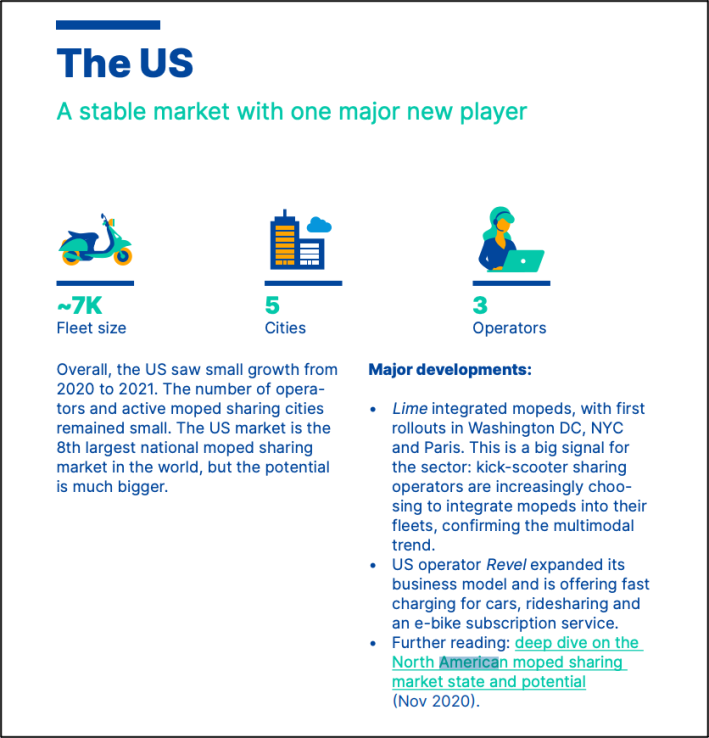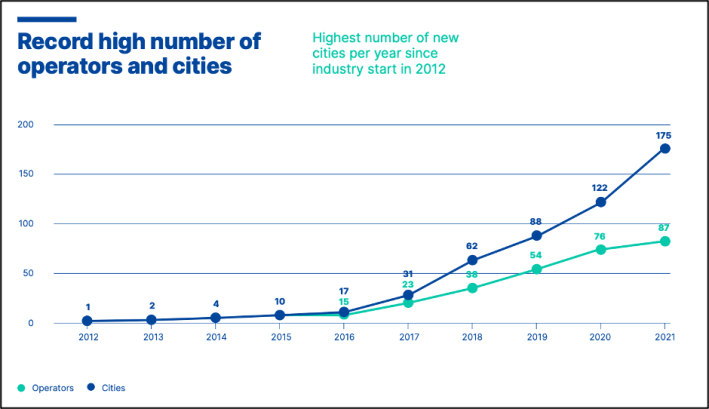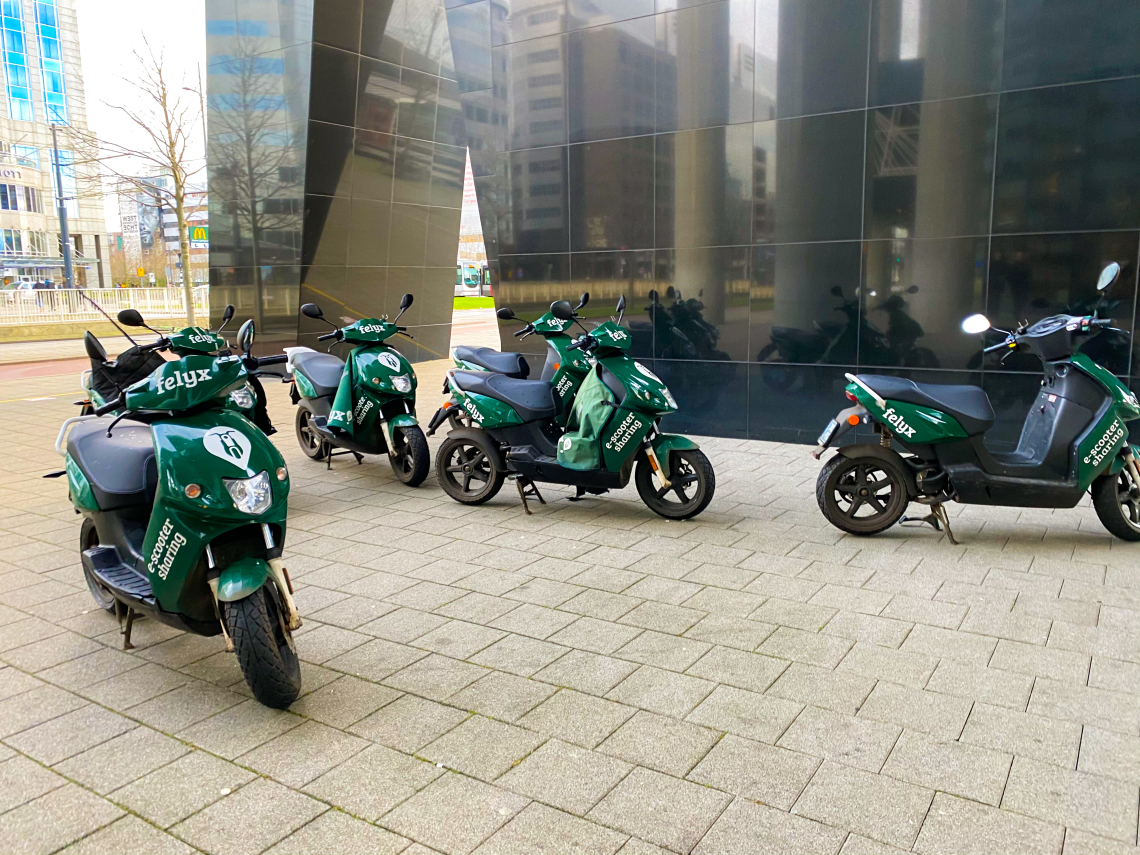Electric moped sharing became one of the most rapidly growing alternatives to driving in cities around the world during 2021, a new report says — but its future in America may be more modest unless local policies catch up with the mid-speed mode.
According to a new study conducted by Enrico Howe of mopedsharing.com and mobility solutions company INVERS, rentable mobility providers reported an estimated 33-percent surge in rider registrations between September 2020 and September 2021, bringing global ridership totals over 12 million for the first time. Cities that have made an active effort to limit car dominance, like Paris and Berlin, have experienced the most growth.
U.S. communities, by contrast, have been slower to get drivers out of cars and onto rentable mopeds. Not to be confused with wildly popular stand-up electric kick scooters that proliferated across the country in 2017, sit-down mopeds (see Streetsblog's Field Guide here) have struggled in auto-dominated American cities, despite the fact that sit-down moped companies started the micromobility revolution back in 2012 with the launch of Scoot Networks. Today, just five markets currently have access to the mode — New York City, Miami, Washington, D.C., San Francisco and a modest fleet in Pittsburgh — and only three operators (Revel, Bird-owned Scoot, and Lime) are currently competing to put butts on seats.
Still, researchers think more U.S. cities could join the ranks of global moped sharing capitals soon — if American leaders would take action to make their streets more hospitable to the emerging mode.
"Against all odds, eight percent of the global moped sharing fleet is situated in America," said researcher Howe, the lead author on the report. "One in 11 shared mopeds is on a U.S. street right now. The growth is not outstanding, but it is happening."

In some ways, the fact that moped sharing has even remained a stable fixture of the U.S. transportation landscape is noteworthy, even if it hasn't yet taken off the way it has abroad. With max speeds capped around 28 to 30 miles per hour, shared moped riders aren't safe driving on high-speed, auto-dominated arterials that lattice many American cities, but they're far too fast for the often scant bike lanes and sidewalks afforded to even-more-vulnerable road users. (Frank Reig, CEO of the moped company Revel, blamed Austin's "deep-rooted car culture," autocentric infrastructure, and sprawling land use when the company pulled out of the Texas capital last year.)
Scarcity of shared mass modes has also made mopeds an awkward fit for stateside transportation networks. Researchers say the vehicle is a natural fit for first- and last-mile travel, particularly for travelers who are trying to quickly get two people to a bus or train; The report estimates that roughly half of all rentable moped trips carry two passengers, at least when the operator provides two helmets in the vehicle's cargo cabin.
"Shared mopeds and transit really do go hand in hand," said Alex Gmelin, CPO at INVERS. "[Transit] becomes more attractive the more mopeds there are. ... It's the right vehicle for a lot of mobility needs."

Mopeds may have also not taken off in the U.S. because of the uncertain space they occupy in the dialogue over how to keep other car-free travelers safe.
Historically, sustainable transportation advocates have expressed fears that accelerating the micromobility revolution — nevermind increasing its weight to roughly 200 pounds — might spell trouble for pedestrians, cyclists, and assistive device users, even as they recognize that drivers present a far greater threat to road safety on the whole. Four widely reported deaths involving Revel scooters in the company's flagship city of New York helped stoke the controversy, perhaps none more so than a 2020 crash in which one of its riders killed an 82-year-old pedestrian. (The other three deaths occurred following single-vehicle crashes; one more Revel rider was killed by an allegedly drunk SUV driver in September.)
The company later introduced a raft of new safety measures, including driver assistance features that advocates have long argued should come standard on any motor vehicle, like systems that automatically detect when a rider is going the wrong way down a one-way street or entering a heavily pedestrianized area like a park; repeat offenders are banned from the platform.
And as the fracas dies down, researchers are reminding advocates of moped sharing's potential to get people out of cars — if U.S. streets can be reimagined to make travel on a cage-free, 200-pound motor vehicle every bit as comfortable and safe as it is in a heavily-armored, 2,000-pound truck.
As American cities shift their infrastructure, policies, and culture away from private automobile dominance, the researchers behind the new report argue that shared mopeds could naturally become a bigger part of the transportation landscape, particularly for trips that are a little too long for a walk — they note that the typical ride is about five miles in duration — and that need to be completed more quickly than even an e-bike can manage. They also acknowledge that it won't appeal to every rider — three out of four moped-share users worldwide are male, roughly on par with shared kick scooter riders — but that isn't necessarily a problem.
"A moped isn’t a perfect choice for, say, a parent who wants to carry a small child," said Howe. "[But] that’s not the goal. The goal is to draw away from individual car ownership that’s attractive to people because it’s safe, it’s cheap, it's reliable, it's fast, and meets their needs. That's often what a moped is best at doing."
What might be most exciting about moped sharing, though, is how it introduces its riders to the broader universe of shared mobility options, especially as the mode becomes more deeply integrated into mobility-as-a-service apps — a trend that the researchers noted was particularly prevalent last year.
"In the end, it’s about having a good alternative to the privately owned car," added Gmelin. "This mode brings more people into this entire ecosystem of shared mobility, and that's a very good thing."






